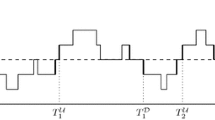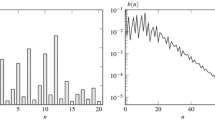Abstract
It is well known that a simple relation called proportional relation holds for some queueing models, that is, the stationary queue length distribution of one system can be expressed as the product of a constant and the distribution of another system which is different only in the buffer capacity. Recently, the proportional relation has been verified for various discrete-time single-server queues with correlated arrivals, where it has been also shown that the proportional constant can be expressed in terms of the distribution of one system. This implies that the stationary queue length distribution of one system can be completely expressed in terms of the distribution of the other system. In this paper, we consider a generalized model of discrete-time single-server queue, which covers all previous ones, and give a simple and unified proof to the proportional relation as well as the expression of the proportional constant.
Similar content being viewed by others
References
C.G. Cassandras and S. Lafortune, Introduction to Discrete Event Systems (Kluwer Academic, Boston, 1999).
X. Chao and M. Miyazawa, On truncation properties of finite-buffer queues and queueing networks, Probab. Engrg. Inform. Sci. 14 (2000) 409-423.
P. Glasserman and W.-B. Gong, Time-changing and truncating K-capacity queues from one K to another, J. Appl. Probab. 28 (1991) 647-655.
F. Ishizaki, Exact relation between loss probability and queue length in an ATM multiplexer with correlated arrivals and periodic vacations, in: Proc. of the 14th Internat. Conf. on Information Networking (ICOIN-14), 2000, pp. 1A-3.1-1A-3.8.
F. Ishizaki, On-line concurrent estimation of priority queueing systems with feedback controlled and non-renewal input streams, in: Proc. of 39th IEEE Conf. on Decision and Control, 2000, pp. 406-411.
F. Ishizaki, G.C. Lin and T. Suda, On-line sensitivity analysis of feedback controlled queueing systems with respect to buffer capacity, in: Proc. of 38th IEEE Conf. on Decision and Control, 1999, pp. 40-50.
F. Ishizaki and T. Takine, Loss probability in a finite discrete-time queue in terms of the steady state distribution of an infinite queue, Queueing Systems 31 (1999) 317-326.
J. Keilson, The ergodic queue length distribution for queueing systems with finite capacity, J. Roy. Statist. Soc. Ser. B 28 (1966) 190-201.
J. Keilson and L.D. Servi, Blocking probability for M/G/1 vacation systems with occupancy level dependent schedules, Oper. Res. 37 (1989) 134-140.
M. Miyazawa, Comparison of the loss probability of the GI X /GI/1/k queue with a common traffic intensity, J. Oper. Res. Soc. Japan 32(1989) 505-516.
Author information
Authors and Affiliations
Rights and permissions
About this article
Cite this article
Miyoshi, N., Ishizaki, F. A Unified Approach to the Proportional Relation for Discrete-Time Single-Server Queues. Queueing Systems 42, 201–212 (2002). https://doi.org/10.1023/A:1020109105773
Issue Date:
DOI: https://doi.org/10.1023/A:1020109105773




